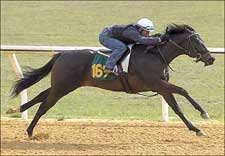EQB – Fatigue Curve Analysis
Fatigue Curve Analysis
Pioneers in Fatigue Curve Analysis —
Selecting the Ideal Racing Distance and Surface for Each Horse
As pioneers in logarithmic velocity decay fatigue curve analysis, EQB successfully adapted Logarithmic Fatigue Curves (decedents of Tesio’s ergograms of pace handicapping and adapted from the Olympic Sportsmedicine Committee findings way back starting in 1977) to horse racing to make reliable determinations about the distances and surfaces best suited to a horse’s individual performance characteristics. Fatigue curve analysis informs the selection of races to maximize a horse’s competitive development and earnings.
By itself, this technology is a significant predictor of subsequent stakes-caliber performance. However, when coupled with traditional selection criteria and other newer techniques — i.e. cardiovascular (heart) 2-D echo ultrasound scanning — the significance of the regression results for performance prediction becomes quite impressive (and unique) in the Thoroughbred racing industry. Consequently, EQB can pinpoint with uncommon accuracy the particular races where our horses have the best chances of winning.
This is a tremendous advantage when it comes to cultivating a Thoroughbred’s career and maximizing its earning potential. As with our work in cardio analysis, we have published papers in prestigious, refereed veterinary journals on our innovative work in advanced gait analysis, and we constantly invest to continue to refine and enhance our techniques.
How Fatigue Curves Work
Natural phenomena often decay at consistent (thus predictable) rates. In the case of muscles, the fatigue rate (decay rate in power produced) was found to follow regular, predictable, mathematical, descriptive decay functions (logarithms) that could be customized to the situation (animal, type of activity, type of muscle, and the specific individual). In the 1970s this was adapted for use on specific repetitive movement type athletic performances for the Olympics, such as in swimming and track and field. In Olympic swimmers in the early 1970s it was documented that the velocity decay rate, due to the swimmers’ process of tiring, followed a generally stable logarithmic function for specific competitors. This fatigue rate was extrapolated and thereby used to help predict a specific competitor’s optimal performance distance — and the technique was later expanded for use in rowing and track and field applications.
The System’s Effectiveness
EQB has many years of field-testing for prototypes of the fatigue curve system. One such test compared that year’s results to the Experimental Free Handicap, a traditionally respected year-end industry evaluation method. In that Handicap, the year’s best performers are given theoretical “weights” to carry, in pounds, to even out their performances at a classic distance. The heavier the weight assigned, the more talented the horse is considered to be.
To use this for racehorses, you need to adapt the fatigue rate equations to horses, racetracks and years of racing data — which we have.
That year, after the season ended, the Experimental Free Handicap weighted 23 colts and 23 fillies 115 pounds or higher (that committee’s all-stars). Of those 46 horses, EQB, using fatigue curves during that year, had ranked 43 of them that good in one of their debut races — that is, well before the end of the season and actually near its beginning in many cases.
What EQB Offers Today
Fatigue curve technology can identify which early 2-year-old winners going short can most likely later be classic winners going long.
Within hours of every horse race of 2-year-old Thoroughbreds at major USA racetracks, EQB has used its fatigue curve system to help identify purchase candidates. From there you can take advantage of EQB’s other services and/or we can use our considerable practical experience and expertise in horse racing to add more value to the process.
This techniques aids the trend of major stables acquiring some of their very best horses by buying them “off the track” after one of their first few races races — e.g., Curlin, Big Brown, Da Hoss, Mine That Bird.



